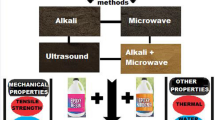Abstract
Spent coffee grounds (SCGs) represent a huge amount of global waste whose post-use disposal triggers environmental issues. In this study, SCGs were successfully treated and modified to improve the mechanical properties of biobased composites with epoxy matrix. A two-step treatment was proposed, pretreating by a NaOH solution and modifying by maleic anhydride (MA). MA acts as a coupling agent to create the internal network in composite through the interaction between functional groups. Accordingly, MA improves the interface between phases in composite, ensures a better physical property compared to the composite without modification. Consistently, the two-step treatment depicts improved mechanical properties: flexural modulus and flexural strength increased to 3053 MPa and 45 MPa, respectively, compared to 2429 MPa and 33 MPa for composite with pure SCGs.
Graphic Abstract










Similar content being viewed by others
References
de Araújo Veloso, M.C.R., Scatolino, M.V., Gonçalves, M.M.B.P., Valle, M.L.A., de Paula Protásio, T., Mendes, L.M., Junior, J.B.G.: Sustainable valorization of recycled low-density polyethylene and cocoa biomass for composite production. Environ. Sci. Pollut. Res. 28, 32810–32822 (2021)
Scatolino, MV, Costa, AdO, Júnior, JBG, Protásio, TdP, Mendes, RF, Mendes, LM: Eucalyptus wood and coffee parchment for particleboard production: Physical and mechanical properties. Ciência e Agrotecnologia 41, 139–146 (2017)
Tucker, C.: Draft: coffee culture: local experiences. Global connections (2011)
Karmee, SK: A spent coffee grounds based biorefinery for the production of biofuels, biopolymers, antioxidants and biocomposites. Waste Manag 72, 240–254 (2018)
Atabani, AE, Al-Muhtaseb, AaH, Kumar, G, Saratale, GD, Aslam, M, Khan, HA, Said, Z, Mahmoud, E: Valorization of spent coffee grounds into biofuels and value-added products: Pathway towards integrated bio-refinery. Fuel 254, 115640 (2019)
Murthy, P.S., Madhava Naidu, M.: Sustainable management of coffee industry by-products and value addition—a review. Resour. Conserv. Recycl. 66, 45–58 (2012)
Lachheb, A, Allouhi, A, El Marhoune, M, Saadani, R, Kousksou, T, Jamil, A, Rahmoune, M, Oussouaddi, O: Thermal insulation improvement in construction materials by adding spent coffee grounds: An experimental and simulation study. J. Clean. Prod. 209, 1411–1419 (2019)
Yoo, J, Chang, SJ, Wi, S, Kim, S: Spent coffee grounds as supporting materials to produce bio-composite PCM with natural waxes. Chemosphere 235, 626–635 (2019)
Wu, H, Hu, W, Zhang, Y, Huang, L, Zhang, J, Tan, S, Cai, X, Liao, X: Effect of oil extraction on properties of spent coffee ground–plastic composites. J. Mater. Sci. 51, 10205–10214 (2016)
Suaduang, N, Ross, S, Ross, GM, Wangsoub, S, Mahasaranon, S: The Physical and Mechanical Properties of Biocomposite Films Composed of Poly(Lactic Acid) with Spent Coffee Grounds. Key Eng. Mater. 824, 87–93 (2019)
Lee, K.-Y., Shamsuddin, S.R., Fortea-Verdejo, M., Bismarck, A.: 2014. Manufacturing of robust natural fiber preforms utilizing bacterial cellulose as binder. J Vis Exp, 51432
Moustafa, H., Guizani, C., Dufresne, A.: Sustainable biodegradable coffee grounds filler and its effect on the hydrophobicity, mechanical and thermal properties of biodegradable PBAT composites. J. Appl. Polym. Sci. 134 (2017)
Leow, Y, Yew, PYM, Chee, PL, Loh, XJ, Kai, D: Recycling of spent coffee grounds for useful extracts and green composites. RSC Adv. 11, 2682–2692 (2021)
Li, S, Shi, C, Sun, S, Chan, H, Lu, H, Nilghaz, A, Tian, J, Cao, R: From brown to colored: Polylactic acid composite with micro/nano-structured white spent coffee grounds for three-dimensional printing. Int. J. Biol. Macromol. 174, 300–308 (2021)
Wongsiridetchai, C., Chiangkham, W., Khlaihiran, N., Sawangwan, T., Wongwathanarat, P., Charoenrat, T., Chantorn, S.: Alkaline pretreatment of spent coffee grounds for oligosaccharides production by mannanase from Bacillus sp. GA2(1). Agric. Nat. Resour. 52, 222–227 (2018)
Nguyen, DM, Vu, TN, Nguyen, TML, Nguyen, TD, Thuc, CNH, Bui, QB, Colin, J, Perré, P: Synergistic Influences of Stearic Acid Coating and Recycled PET Microfibers on the Enhanced Properties of Composite Materials. Materials (Basel) 13, 1461 (2020)
ISO178: plastics—determination of flexural properties. ISO (2019)
ASTMD570: standard test method for water absorption of plastics. ASTM (2018)
Ballesteros, L.F., Teixeira, J.A., Mussatto, S.I.: Chemical, functional, and structural properties of spent coffee grounds and coffee silverskin. Food Bioprocess Technol. 7, 3493–3503 (2014)
Tala, W, Chantara, S: Use of spent coffee ground biochar as ambient PAHs sorbent and novel extraction method for GC-MS analysis. Environ. Sci. Pollut. Res. 26, 13025–13040 (2019)
Farhan, A.M., Dheyab, H.B., Hasan, A.A.: Synthesis and characterization of cellulose grafted maleic anhydride and substituted it with amoxicillin. Eur. J. Pharm. Med. Res. 4, 84–90 (2017)
Daria, M, Krzysztof, L, Jakub, M: Characteristics of biodegradable textiles used in environmental engineering: A comprehensive review. J. Clean. Prod. 268, 122129 (2020)
Wu, H.: Effect of oil extraction on properties of spent coffee ground–plastic composites. J. Mater. Sci. 51, 10205 (2016)
Acknowledgements
The authors would like to thank Région Grand Est, Département de la Marne, Grand Reims, and the European Union for supporting the Centre Européen de Biotechnologie et de Bioéconomie (CEBB 51110 Pomacle, France). This research is also supported by the Laboratoire Innovation Matériaux Bois Habitat, Ecole Supérieue du Bois, Nantes, France, and the Laboratory of Fundamental Materials Science from the Faculty of Materials Science and Technology, University of Science - National University of Ho Chi Minh City (VNU-HCM), Viet Nam.
Author information
Authors and Affiliations
Corresponding authors
Ethics declarations
Conflict of interest
The authors declare that they have no conflict of interest.
Additional information
Publisher’s Note
Springer Nature remains neutral with regard to jurisdictional claims in published maps and institutional affiliations.
Rights and permissions
About this article
Cite this article
Nguyen, D.M., Nhung, V.T., Le Do, T.C. et al. Effective Synergistic Effect of Treatment and Modification on Spent Coffee Grounds for Sustainable Biobased Composites. Waste Biomass Valor 13, 1339–1348 (2022). https://doi.org/10.1007/s12649-021-01566-z
Received:
Accepted:
Published:
Issue Date:
DOI: https://doi.org/10.1007/s12649-021-01566-z




